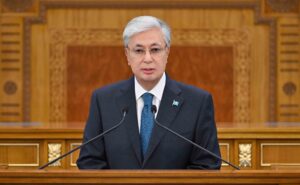Building a Community with a Shared Future: China’s Vision for Global Governance Reform

The traditional division of the world into first, second and third world countries based on their alignment with Western powers has been challenged by the emerging power China. Especially its Belt and Road Initiative (BRI) and other economic projects, starting from region and ranging other parts of the world. This reform initiative of China, will seeks to connect neighboring and developing nations and reshape the process of governing the global economy and governance. As economic development and political stability increasingly define national interests and futures, Cold War terminologies like “first” and “third world” are losing relevance. The Chinese classic Romance of the Three Kingdoms opens with the line, “The world is divided and falls into chaos after long peace in unity and is united again from chaos.” This cyclical idea of unity and disorder echoes Hegel’s dialectical process and supports China’s vision for building a shared community of the future, which is a principal target of its foreign policy.
The core idea of reforming global governance and building a shared future through cooperation and development rather than power and dominance can be traced back to ancient China’s idea of Tianxia (“all under heaven”). This envisioned the entire human civilization as a single moral and political community governed by harmony, justice, and human order. While speaking at the United Nations Office in Geneva, President Xi Jinping focused global governance, is very much essential for the survival of humanity now. Professor Wang Yiwei, in his article Three Dimensions to Understand a Global Community of Shared Future, discusses the historical, practical, and geographical dimensions of this vision in his comprehensive style, describing it as “a proposal for common prosperity and an inclusive international system” (Yiwei, 2018).
Highly claimed western values of sovereignty and non-interference, originating from the Treaty of Westphalia (1648), emphasize respect for the autonomy of modern states, a principle China upholds by promoting equality among nations, opposing external interference, and protecting internal affairs. International humanitarianism, centered on promoting global welfare and cooperation, very much connected with China’s vision for global governance and shared community. This shared future framework aligns with the UN Charter’s principles of peace, equality, and cooperation, aiming at strengthening the state through cooperation not to replace them with power.
The ripple model theory explains China’s gradual, peaceful approach to reforms, spreading influence outward through cooperation rather than dominance and unjust norms like contemporary west had showed in case of Libya and Iraq. China’s domestic modernization, economic policy and future planning extend into regional initiatives such as the BRI, Global Development Initiative (GDI) and cultural diplomacy embodies a reformed model of global economy and governance. In a nutshell, BRI seeks to improve infrastructure connectivity, align national policies and strategies, promote practical cooperation, and coordinate development across region to achieve common prosperity (Aris, 2016 ). As Yiwei (2018) notes, developing countries will ultimately become part of shared community, through independent growth and regional partnerships, including the Shanghai Cooperation Organization (SCO) and Association of South East Asian Nations (ASEAN).
China’s four confidences (si ge zi xin), in its path, theory, system, and culture, provide the ideological foundation for their vision. Its confidence in developmental path allows China to promote equality among nations as compared to Western model of hypocrisy. Theoretical confidence enables China to contribute highly toward, ideas such as harmony, win-win cooperation, and shared destiny without hegemony or power politics, major to global governance. Institutional confidence allows China to bring reforms in global governance on pragmatic domains, rather than abstract thinking. Cultural confidence gives moral and ethical depth to China’s vision by promoting harmony among nations as a guiding principle for global coexistence.
During the 27th collective study session of the CPC (Communist Party of China) Politburo, Xi Jinping stated that “more challenges in the world call for faster reform of the global governance system,” it highlighted China’s belief, that the existing global governance framework, being biased by Cold War structures and dominated by Western-led institutions like the IMF, World Bank, and WTO, must be evolved (Xinhua, 2016). This call for reforms aligns with the shared future for community development vision of China, which promotes inclusiveness and fairness as essential values for sustaining peace and development.
Some critics had argued that China’s model represents a zero-sum approach, just shifting of global power from the West to the East. However, China’s BRI is going to promote independent development and cooperation, not the transfer of sovereignty, which is quite different form, the Western-led integration models. Its approach reflects a non-zero-sum philosophy, where the progress of one state contributes to the well-being of other states, as CPEC in Pakistan.
It is to be concluded that, China’s vision for global governance and shared future represents a forward looking approach. Through independent and cooperative developments like BRI, GDI, and cultural diplomacy, China’s aim is fair and inclusive, in balancing global order. And shared prosperity and harmony is underlying its confidence in its path, system, and culture.


